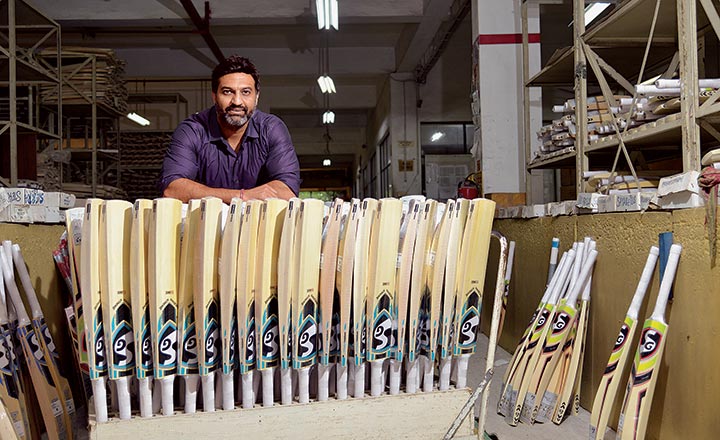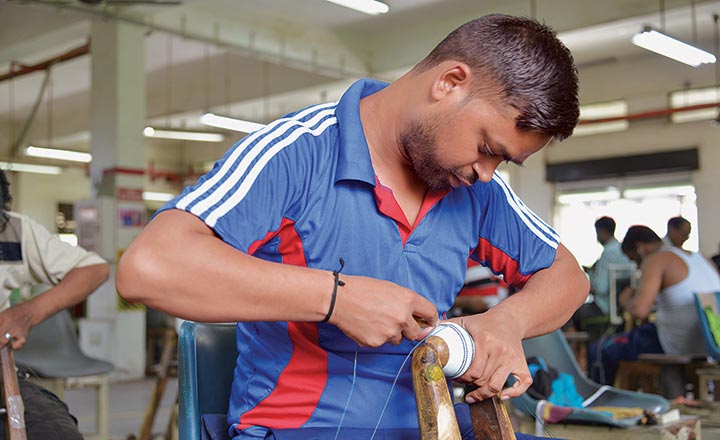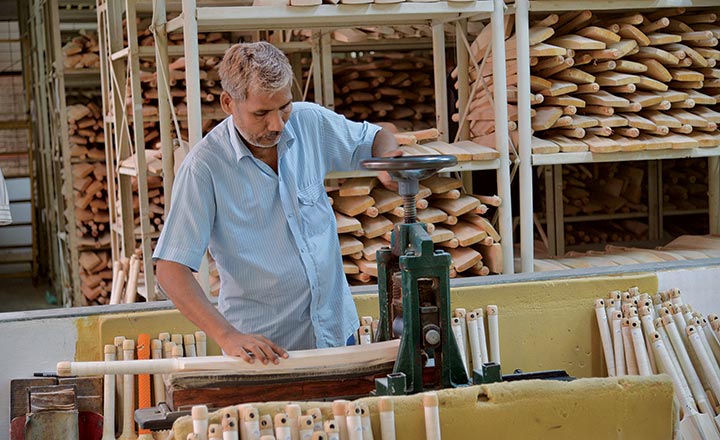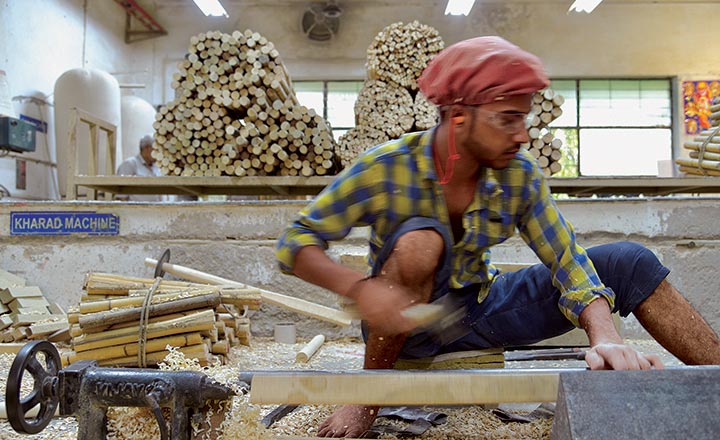It’s an 18th century game, which an 87-year-old Indian company continues to lord over. We are referring to Meerut-based Sanspareils Greenlands (SG), the country’s biggest exporter of cricket gear by value and the largest manufacturer of cricketing equipment by volume in the world. SG found a new lease of life back home with the advent of the Indian Premier League (IPL). Despite major sports brands such as Nike, Adidas and Reebok wading into the cricket gear market, SG has held its ground and today has an unassailable lead. It continues to be the prime supplier to the world’s richest cricketing board, the BCCI. Its ability to spot talent and nurture them has been phenomenal — there are 12 international cricketers, 25 IPL players, 100 first class cricketers sponsored by SG. It is now looking to diversify by launching sports training apparel. Although a highly competitive market, SG’s ability to create a niche might just work for it.
A man carefully binds two halves of a leather ball with a needle and thick thread. Seated on a high stool, he is engrossed. Similarly, scores of workers are busy working in this large airy room, performing a variety of tasks — cutting leather, finishing it, fitting the halves over the core of the ball. The precision with which the workers go about their work clearly shows the job at hand is more of a craft. And this is the cricket ball section of the Meerut-based Sanspareils Greenlands (SG), the largest cricket equipment maker in the world.
While the enterprise churns out thousands of cricket bats, balls, wickets, pads, kits, and other accessories, its hallmark is the handmade ball. One such ball created history. Paras Anand, director, SG, can’t forget that day. “It was one of the greatest moments; not just for cricket and India, but even for SG. It was one of our handmade balls with which Anil Kumble took all the 10 wickets against Pakistan in February 1999 at the Feroz Shah Kotla stadium in Delhi.” SG willows, too, find a place in cricketing history. The company sells 350,000 bats a year now. Legends such as Sunil Gavaskar, Rahul Dravid, and Virender Sehwag have played with SG bats for decades. Gavaskar scored his 10,000th test run and raised his SG bat. Everytime that picture appears in the media, it makes Anand proud. It’s been an eventful journey for this niche sports good company, whose foundation was laid in Pakistan.

Early innings
Paras belongs to the third generation of the Anand family. His grandfather, Kedarnath Anand, started the company way back in 1931 in Sialkot, which lies in present-day Pakistan. At that time, SG exported equipment for tennis, hockey, and football. But post the partition, in 1947, when the Anands shifted to Meerut, the focus of their business shifted to cricket. The government’s support to the migrating sports equipment industry, in terms of subsidised land, helped them get back on their feet within a decade. By the 1960s, SG restarted exporting to countries such as New Zealand, Australia, the UK and even France. By the early 1980s, the demand for cricketing goods was growing and it spiked after India won its first Cricket World Cup in 1983. An Allahabad-based company Symonds used to be the domestic market leader in the early 80s.
SG’s turning point came when it signed Sunil Gavaskar in 1984 and aggressively promoted the brand in newspaper and magazine ad campaigns. That worked. Towards the end of the 80s, SG became the market leader in India even as rival Symonds faced internal issues and folded up by the late 90s. Post Gavaskar’s retirement in 1988, the company got on board Mohammad Azharuddin. By 1996, the promising and reliable Rahul Dravid became the next obvious choice for the company.
By 2000, exports contributed 80% to SG’s sales and domestic market the rest. However, the contribution numbers flipped over the past two decades. Today, the domestic market contributes an impressive 80% given its hold on cricketing equipment. Cricket is a national pastime and gets played at three levels in the country: professional (national, state, and regional teams), academy/club level and casual cricket. SG doesn’t cater to the casual cricket segment as it is a massive unorganised category whose price point ends at Rs.1,300 a bat, while SG’s bat range starts from Rs.1,500 and goes up to Rs.50,000.
Although SG’s international market contribution is 20%, it continues to be the largest exporter in terms of volume. Rakesh Mahajan, director, B.D. Mahajan & Sons, which also manufactures cricketing gear out of Meerut, says, “ICC over the past few years has added 58 new countries to the list of cricketing nations. Every World Cup, two or three new teams are added. That has helped exports slightly, especially to countries such as the US and Canada.” However, prime export markets such as the UK and Australia have not seen significant growth over the past decade. But with the launch of IPL in 2008, the domestic market exploded. Between FY08 and FY18, SG’s sales grew 4x from Rs.500 million to Rs.2 billion.
“If between 2000 and 2008, the average growth was 7-8%, the domestic cricket equipment market started growing over 15% plus during this period,” informs Anand. That changed the dynamics for the company. “With the advent of T20 after IPL, club cricket and academies became very popular in India. If 10 years back there were 50 cricket academies in Delhi, today there may be 200. That has driven domestic growth for us,” says Anand. Among its prominent clients are BCCI, the Bangladesh Cricket Board, and some prominent IPL teams such as Mumbai Indians, Rajasthan Royals, and Chennai Super Kings.

Master stroke
For any cricket equipment company, getting the right endorser is the most critical aspect of marketing. Not surprising that since inception, the company has made it a key pillar of its business strategy. “We believe this approach not only enhances the credibility of the brand but more importantly serves as an important feedback mechanism,” mentions Anand. For example, while Sunil Gavaskar would choose two bats at the beginning of the season, and give feedback on which was “good” and “very good”, Rahul Dravid turned out to be a demanding perfectionist. “Even if there was a 5 gm variation, he would find out and ask us to fix it. It had an impact on his psyche, and eventually performance,” adds Anand. There was a particular shape of bat which Dravid liked. “When we introduced that very bat in the market, it became an instant hit and continues to sell till date,” reveals Anand. In recent times, the brand has been associated with cricketers such as Suresh Raina, Cheteshwar Pujara, Hardik Pandya, Rishabh Pant, and Krunal Pandya. Internationally, Shane Watson in IPL (Australia), Shakib Al Hasan (Bangladesh), Dimuth Karunaratne and Kaushal Silva (Sri Lanka) have also signed contracts with SG.
Even after working with legends for decades, Anand does admit that player management continues to be a massive challenge. If the cricketer is not able to score in a tournament, it puts a lot of pressure on him. “This gets transferred to the equipment supplier. Then you have to work with him closely, try and counsel him. There could be something wrong with what he is choosing, maybe balance, weight, or shape,” adds Anand.
Two years ago, the company had signed Karnataka all-rounder K Gowtham who was later picked up by Rajasthan Royals for a whopping Rs.62 million. SG closely worked with the cricketer to customise gears for him. “I often visited their factory and got valuable advise from experts on gear selection,” states Gowtham. Cricket bat weight is a knotty issue that batsmen often deal with. “I was advised on how to pick the willow, what kind of weight I can use? Ultimately, we figured out that a little heavier and slightly lengthier than normal bat would go best with my body and playing style,” adds Gowtham.
Anand recalls working with one of the edgiest players of Indian cricket, Suresh Raina, who had signed a contract with Adidas in the past. Anand says, “They were not able to provide him the right equipment, which affected his performance.” Just six months ago, he came back to SG. “We counseled, advised and experimented with his gear. Now he has seen decent success in IPL and also got selected again in the national cricket team.”
With the likes of Nike, Adidas, and Puma offering up to Rs.100 million to top players such as Virat Kohli and MS Dhoni for using their bat, homegrown equipment companies such as SG have to plan their marketing smartly. If you are not picking Kohli or a Dhoni, an Indian player can cost you anywhere between Rs.7.5 million to Rs.20 million with most contracts for two to three years.
SG tries to target and pick talent early on. Hardik Pandya who has become a hot property now, was contracted before he became famous. “Now we can’t afford him,” laughs Anand.
Nikhil Bardia, head (sponsorship sales), IMG Reliance, which manages Hardik Pandya, says, “It’s been a mutually beneficial relationship. The company has spent a lot of time with Hardik to understand his specifications and comfort, especially when it comes to selection of bats. Being a middle order batsman, it’s essential that he is comfortable with the gear. This is where clear and meaningful communication between an athlete and equipment supplier is of utmost importance.”
Anand adds,“Now we have become more aggressive in identifying young cricketers. We work closely with players in the under-19 team, with IPL players and even at the international level. We have players from West Indies, Sri Lanka, and Bangladesh too.”
The company has a strong sports marketing team which stays in touch with top coaches in major cities of the country to identify upcoming talent. “At that age of 16 or 17, quality equipment offered free is a lucrative option for most,” says Anand. Some of their early finds such as Prithvi Shaw and Shubman Gill have already moved on to sponsors such as MRF.
Anand feels that the challenge will always remain because these are corporates with massive marketing budgets. However, in recent times MNCs such as Adidas, Nike, Reebok have either exited the cricket equipment business or are slowly moving out. “We had been fighting with these MNCs earlier. They later realised that cricket equipment is not a big market. At Rs.2 billion, we are the largest player. But it takes lot of time and resources. Four years ago, every second player was playing with a Nike bat. Now they have completely shut. Adidas is also slowly moving out,” reveals Anand. SG continues to do contract manufacturing for leading global cricket and sports companies as suppliers. Around 35% of cricket bats made in SG’s factory are supplied to such companies.

New innings
As we pace around the shop floor, Anand gets hold of a cricket bat, takes a batsman’s stance and enacts a straight drive. Then to our surprise, he reveals, “I am a tennis player.” While cricket remains the company’s mainstay and will continue to be the core category for the next five years, Anand has not shied away from looking beyond cricket equipment.
According to MarketResearchNest, the global cricket equipment market was valued at $13 million in 2017 and will reach $16 million by the end of 2025, growing at a CAGR of 3.2% between 2018 and 2025. Not surprising then that SG changed gears and shifted to the domestic market which is twice the size of the international market and is growing at high double digits.
However, to de-risk the core business, SG opened up two new categories — apparel in 2004 and footwear in 2006. Both categories contribute 5% each to the company’s revenue. Currently, bats, gloves and pads account for 35% of sales, balls 10%, helmets and bags 10%. However, its apparel and footwear, despite lower contribution, is growing at a faster pace — 30% in the past few years. These non-core categories have given Anand confidence to look even beyond.
In 2013, the company had launched non-cricket sports apparel and footwear brand, Maxxport. After running it for four years, the business was wound up. The company now wants to launch sports training wear under the SG brand in the summer of 2019. “Our earlier approach didn’t work. Now, we are planning to leverage SG’s brand which is more popular and widely accepted,” admits Anand.
While the average price of a Reebok or a Nike product is about Rs.1,200, a domestic brand costs around Rs.400. SG is positioning itself in between. “We have identified our niche and will offer products which are at par with the international brands in terms of quality but are 20-25% cheaper,” says Anand, adding, “We would like to migrate from just cricket to training as a category.” For that to happen, SG needs to play a long and patient innings — a trait that the Anands have mastered over the years.











